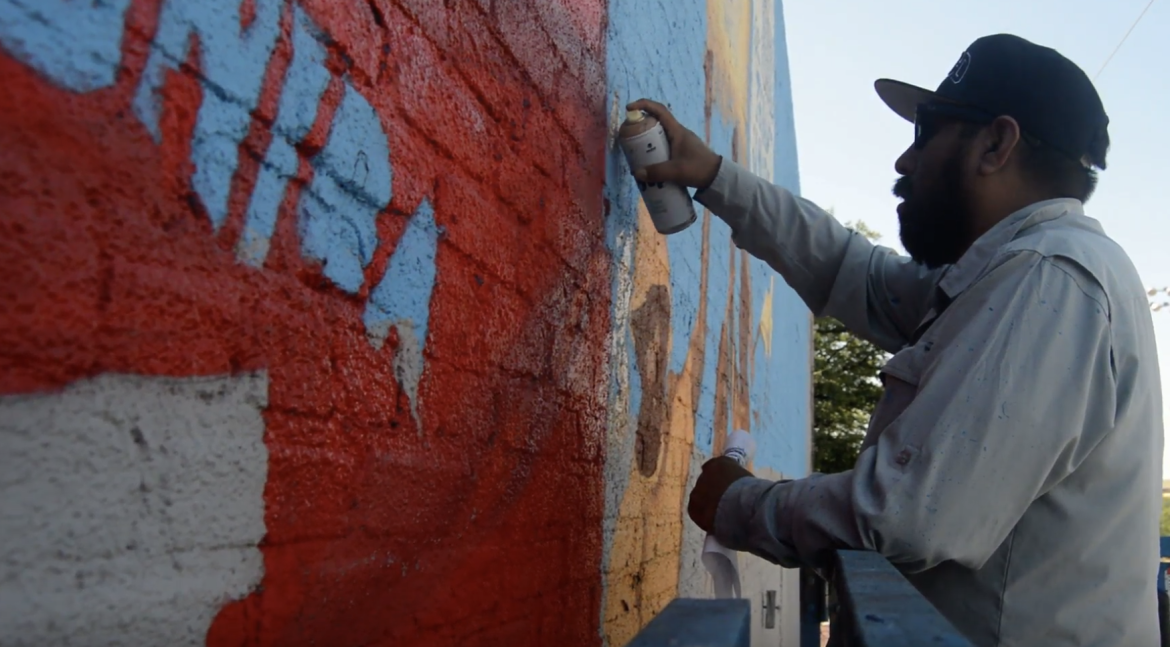By Lance Liguez, David Shabazz and Miglena Sternadori
On a crisp Monday morning, a broad-shouldered man in camo pants and his 5-year-old son walk up to a large painting on a concrete slab near the Boys and Girls Club of El Paso. The man gazes up at a collage of bright-colored images. His lips curl up into a subtle smile.
The man’s name is Gabriel Calderon. He lives in Segundo Barrio, a working-class neighborhood of El Paso, a few blocks from the U.S.-Mexico border. Calderon, 27, grew up here and has come to see the mural — it’s new, he says. It is one of dozens, perhaps hundreds, across the border city.
“When I was younger, this wasn’t something that you would see often, artworks and stuff,” Calderon reminisces. “I remember this wall was all tagged up at one point.”
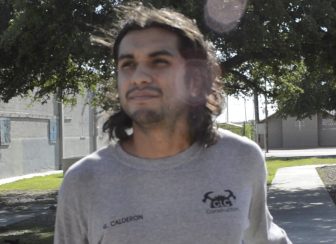
Gabriel Calderon, 27, says he doesn’t remember a lot of public artwork in Segundo Barrio during his childhood. Photo by Lance Liguez, Borderzine.com.
Now, the wall is a collage of intersecting storylines from his neighborhood, the first stop for many immigrant residents, who themselves live at the intersection of two worlds. Calderon says the people and the symbols in the mural speak to him directly, reflecting the struggles of his immigrant parents and the indigenous heritage of many local residents.
“You can tell from the bottom, like, that’s very much Aztec or Mayan architecture going into more realism,” he says. “That right there is an apartment complex that I have seen down the street. The artist himself understands our culture extremely well.”
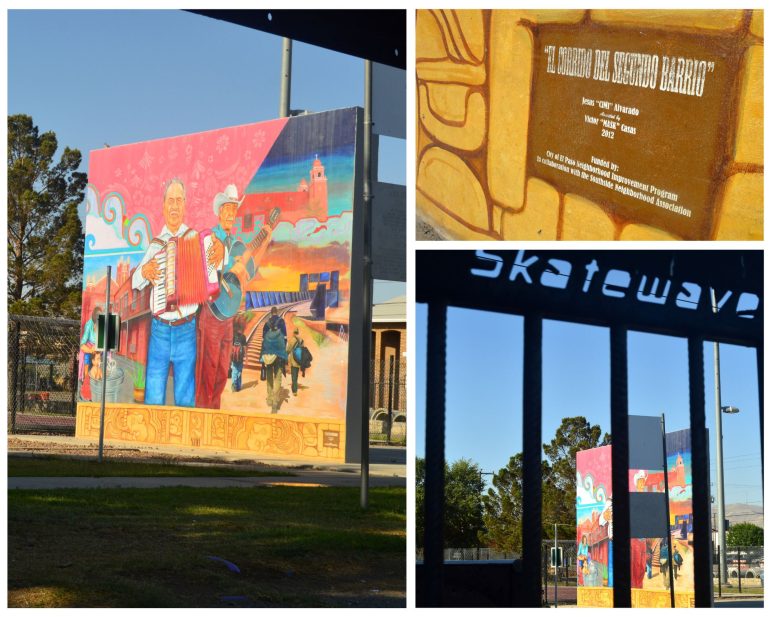
“El Corrido del Segundo Barrio,” left, juxtaposes two musicians in the foreground with tenement dwellers and weary border crossers at the Juarez-El Paso bridge in the background. Neighborhood resident Gabriel Calderon says the configuration makes sense: “In our culture, we’re very much about celebrating things. Every day is a new day and we’re grateful for it.” Photo collage by Miglena Sternadori, Borderzine.com
The artist is Jesus “CIMI” Alvarado, who has been painting murals for more than a decade. The driving force behind his art reflects a focus on both the future and the past. He wants to bring forth change and is also pained by the knowledge that schools don’t teach local residents about the history forged by their ancestors and contemporaries.
“A lot of my work, most of my work, is what I call stories from our communities,” Alvarado says. “I like to talk about how the system itself is not telling those stories.”
His current project, which Alvarado describes as telling “the story of the Chicano movement, not only in El Paso but more specifically in El Segundo Barrio,” is starting to come to life. Its canvas is a two-story high wall that faces a skate park, just yards from the multi-colored slab Calderon was admiring. The words “tenants union” at the top of the unfinished mural speak to the housing struggles of former tenement residents — a struggle Alvarado understands well because he grew up in a family of six sharing two rooms.

As he readies to continue working on his mural in progress, Alvarado sports a cap that says “Chuco,” referencing El Paso’s nickname, El Chuco, because of the city’s influence on the Pachuco style of the 1940s. Photo collage by David Shabazz, Borderzine.com
Standing on top of a rig, the artist pushes a button, sending the engine into a wild rumble. The shaky platform slowly rises toward the top of the wall. Then, with the steady arm of a seasoned graffiti artist, he shakes a can of spray paint and begins to transfer a concept drawing from a piece of paper onto the wall.
When the mural is completed, in about two months, Alvarado says, it will feature several local change-makers, interweaving their stories in a public archive of sorts. One storyline will center around Carmen Felix, a former housing activist described by the El Paso Times in 1988 as the city’s “No. 1 hell-raiser.” Another thread within the mural will be about one of Alvarado’s mentors, Oscar Lozano, a former high school teacher who taught Chicano Studies and is now a history professor at El Paso Community College.
“We want our community to remember them,” Alvarado says. “We want to recognize them while they are still alive.”
The gravity and significance of the project seem at odds with the means: spray paint. In the 1990s, one El Pasoan who opposed public artwork reflecting the city’s border culture called murals “an extension of graffiti.” It was supposed to be a takedown of an art form rooted in the progressive Mexican Muralism movement of the early 20th century. But Alvarado, who started as a graffiti artist and owns what some might describe as a graffiti shop, doesn’t mind the word.
“That line (between graffiti and murals) is only in our mind,” he says. “I see a lot of people doing different things with spray paint. There’s a lot of things that have evolved.”
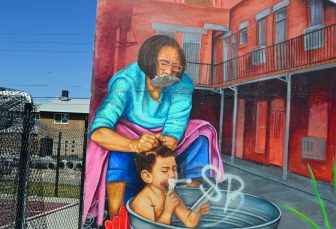
A mural tagged by vandals. Photo by Miglena Sternadori, Borderzine.com
“People like to vandalize things, and it’s sad, you know?” Calderon says. “I’m okay with graffiti, but what I’m not okay with is when you do it over somebody else’s art.” Alvarado, the artist, disagrees. “I think there’s a misconception about what graffiti is,” he says. “I think that’s tagging and that’s vandalism.” He says it means a lot to him that what’s likely the work of a rambunctious youth hasn’t spiraled into more vandalism. “It’s been like that for a few years and I haven’t fixed it,” Alvarado says. “The community itself is more mad about it than I am, and that’s rare. There’s a lot of respect in this community for art.”
Like Alvarado, barrio artist Victor Casas (aka Mask) says murals are mirrors of the community, reflecting things that are not necessarily on TV but are on people’s minds. One such example is young people who join the military in order to afford college. A vet with three tours to Iraq under his belt, Casas speaks from experience. He joined after 9/11 because he thought he would be drafted anyway and didn’t want to get “thrown out there” without any training, like what happened to many Vietnam veterans.
Casas’s current project, which he describes as a surrealist dream-state-like artwork, is meant to reflect on the connection nearly every family in the neighborhood has with the military. He wants to pay respect to veterans, including those who have been deported. “The majority end up coming back home in coffins,” Casas says. “So here I will be adding what will be mimicking, like, the border wall, and a casket coming, in between it.” The mural’s storylines will also reference the Iwo Jima Memorial, the Vietnam Memorial and Company E, a largely Mexican-American unit that fought in World War II.
“Every bit of it has to do with my time in the service,” Casas says. His roots in the community serve as the lens through which his military experience is refracted. At the center of the unfinished artwork is the word “valor,” which Casas chose because of what it means in both English (courage) and Spanish (value). Medal of Honor stars are sprinkled on top and around it, alongside an image of the American flag, which also appears in the mural’s lower left corner, draping a military coffin.
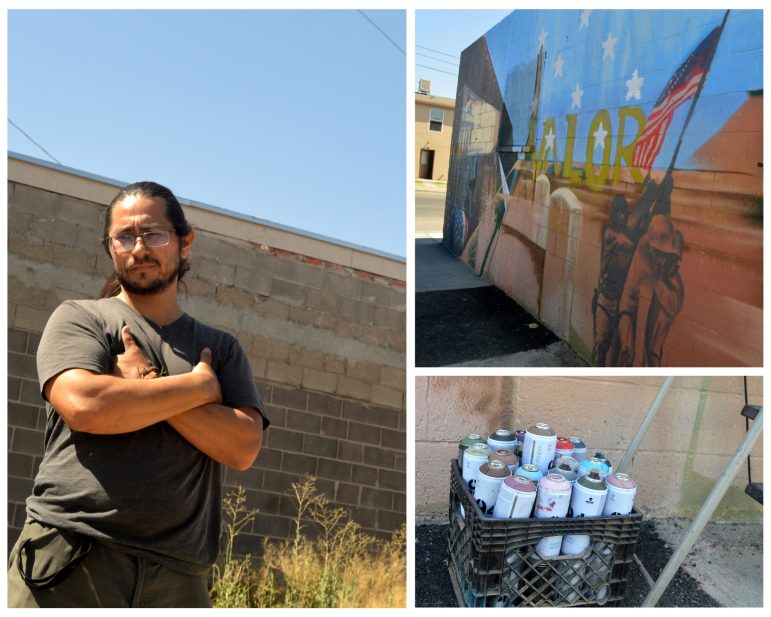
Victor Casas says his murals are mostly self-funded through sales of prints and other artwork. “A lot of times friends and family buy me paint,” he says. “There’s also times when I’m painting and people come by and they want to, like, help out. And I just tell them, ‘Hey, look, this shop is right down the street. Buy me some paint.’” Photo collage by Miglena Sternadori, Borderzine.com
At one point, Casas considered including the Mexican flag as a background for the coffin draped in the American flag but decided against it. “I didn’t do it because the people getting deported are not just Mexican,” he says. “That would not represent them. So I kept it as is.”
The importance of accurate representation is big on other artists’ minds as well. Alvarado, for instance, says there is a lack of representation of women in murals. That observation seems true not only in regard to murals’ subjects but their creators as well. “Art has a tendency to be so male-driven and maybe, you know, more men tend to get a little bit more spotlight,” says artist Christin Apodaca. “But I want people to know that women are out here doing more, doing a lot of work, if not more than men.”
At the Artspace El Paso Lofts downtown, Apodaca has spent much time thinking about and incorporating themes centered around women’s representation into projects of paint, pencil and markers. A Latinx Latte soy candle fills the space with the sweet aroma of black cardamom and cream. “In a lot of my pieces, I love to feature women,” Apodaca says. “I mean, I am one, so it comes from my personal experience existing as one. I like to make them big and present and a big life force that kind of exists within all.”
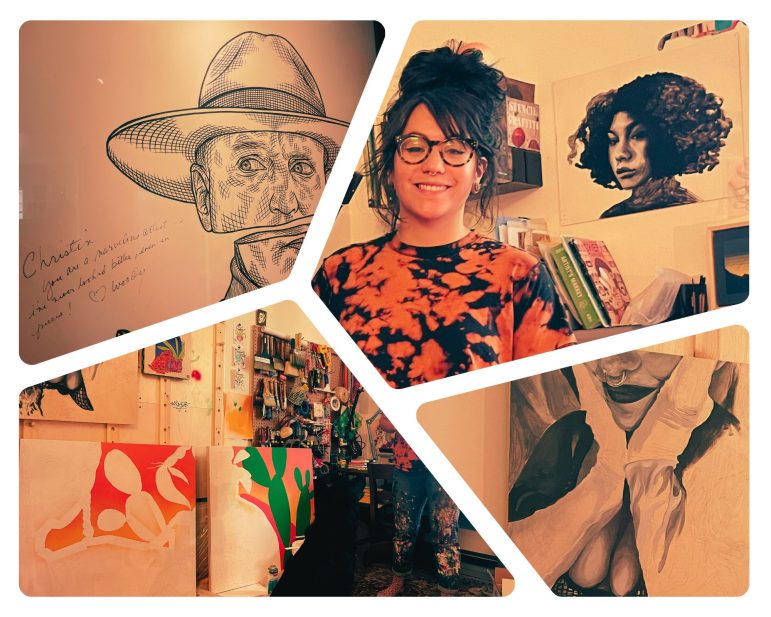
Christin Apodaca describes the main themes in her art as love, strength and ways of overcoming: “a lot of personal things a lot of women go through,” she says. One of the prints hanging on her apartment walls is a drawing of Woody Harrelson, autographed by the actor himself. “Christin, you are a marvelous artist,” the inscription reads. “I’ve never looked better, even in pieces!” Photo collage by Miglena Sternadori/Borderzine.com
Her canvas ranges from a half-sheet of paper to electrical boxes to wall-sized murals. One, also in El Segundo Barrio, depicts a woman’s face amid intertwining cacti — one of her favorite symbols, she says, because “they’re really beautiful but also a little dangerous.”
No matter the medium or the subject, Apodaca believes she and other local artists have much in common. “We all make things for our community and create spaces where you have something really fun to look at and think about,” she says. “And, you know, a lot of history is on the wall.”
It’s this multilayered history that seems to boost El Paso’s growing reputation as a city of murals. In 1995, University of Vermont education professor David Conrad described the mural form as “a democratic art with immense capacity to strengthen and expand multicultural understanding,” But it may also be the other way around: the amalgamation of cultures drives creative public expression.
Calderon, the Segundo Barrio resident who discerned first-generation-immigrant struggles in CIMI’s completed Boys and Girls Club mural, says other “Latino-dominated” places he’s visited don’t measure up to El Paso: “You know, here we blend in.” At night, he likes to walk around and gaze at the city lights of El Paso and Juarez. And then, he finds what he is looking for: There’s a certain point where you don’t see the bridge, you don’t see the wall. You just see the countries, you know, for what they are.”
This story was produced as part of the 2023 Dow Jones News Fund Multimedia Training Academy hosted at UT El Paso. The academy trains college and university journalism professors from Hispanic-serving institutions and Historically Black Colleges and Universities in media creation and editing to help them prepare their students for multimedia career opportunities.

